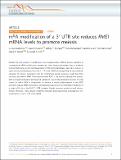m⁶A modification of a 3′ UTR site reduces RME1 mRNA levels to promote meiosis
Author(s)
Bushkin, G. Guy; Morgan, Jeffrey T. (Jeffrey Thomas); Richardson, Kris; Lewis, Caroline; Chan, Sze Ham; Bartel, David; Fink, Gerald R; ... Show more Show less
DownloadPublished version (1.501Mb)
Terms of use
Metadata
Show full item recordAbstract
Despite the vast number of modification sites mapped within mRNAs, known examples of consequential mRNA modifications remain rare. Here, we provide multiple lines of evidence to show that Ime4p, an N6-methyladenosine (m6A) methyltransferase required for meiosis in yeast, acts by methylating a site in the 3′ UTR of the mRNA encoding Rme1p, a transcriptional repressor of meiosis. Consistent with this mechanism, genetic analyses reveal that IME4 functions upstream of RME1. Transcriptome-wide, RME1 is the primary message that displays both increased methylation and reduced expression in an Ime4p-dependent manner. In yeast strains for which IME4 is dispensable for meiosis, a natural polymorphism in the RME1 promoter reduces RME1 transcription, obviating the requirement for methylation. Mutation of a single m6A site in the RME1 3′ UTR increases Rme1p repressor production and reduces meiotic efficiency. These results reveal the molecular and physiological consequences of a modification in the 3′ UTR of an mRNA.
Date issued
2019-07Department
Whitehead Institute for Biomedical Research; Massachusetts Institute of Technology. Department of BiologyJournal
Nature Communications
Publisher
Springer Science and Business Media LLC
Citation
Bushkin, G. Guy et al. “m⁶A modification of a 3′ UTR site reduces RME1 mRNA levels to promote meiosis.” Nature Communications, vol. 10, 2019, 3414 © 2019 The Author(s)
Version: Final published version
ISSN
2041-1723